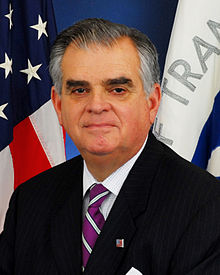This article is a little dated, but covers an important view into the subjects of America 2050, “megacities” and the connecting high-speed rail network. The press is giving slight coverage, with little or no background to present the entire picture.
To boost infrastructure and build Agenda 21 high-speed rail systems (HSRS) across America, (former) Transportation Secretary Ray LaHood stated (in 2012) that $470 million in unspent funds (were) still available to states for such projects.
In 2011, Obama called for these HSRS to be built in America within the next 25 years. In California, government funding for a HSRS across the Central Valley trades $4.5 in bonds for $3.2 billion in federal stimulus for a railway that links to transportation lines.
The high speed railway is the brainchild of America 2050, a non-governmental organization that supports Agenda 21 policies in the US. America 2050 claims that the railway will provide more trains to the growing population in California and that this endeavor is necessary to “close the gap” between Northern and Southern California.
Curt Pringle, Anaheim mayor asserts that the HSRS will “be much more convenient than taking a plane and certainly much easier in time and fatigue than driving.”
Along with California, HSRS will be built with private industry and government funding in Florida, Illinois, New England and along the entirety of the Pacific Northwest. This endeavor is estimated to cost $8 billion to the taxpayer.
The Florida High-Speed Rail Authority has estimated their project to cost $27 million per mile. When other project’s estimated costs are added up, it may run over $90 billion which exceeds the $8 billion set aside by the US government.
In the Department of Transportation (DOT) in conjunction with the Department of Energy document, Vision for High-Speed Rail in America Final FRA HSR Strat Plan, LaHood states that “regional high-speed corridors” will connect mega-city residents in “selected US corridors” in an energy efficient and climate change reversing transport system.
Championed by Obama, the development of a “comprehensive high-speed intercity passenger rail network will require a long-term commitment at both the Federal and State levels.”
America 2050, in line with Agenda 21, wants to see high speed railways built along the east and west coasts of America. These railways will link the megaregions and megacities which create Cascadia Final Ecolopolis 5 HSR in Cascadia May 4; an amalgamation of Seattle, Portland, and Vancouver, British Columbia with a high speed rail will ensure the protection of designated habitats for animals.
Cascadia will begin in Northern California and extend along the Pacific Ocean.
The Ecocity Builders is a non-profit organization which is a collaboration of international networks of associates that influence and actively participate in local city planning projects all across the US. They focus on reworking current issues to match UN Agenda 21 guidelines in planning for local cities including transportation, energy, architecture, design, natural restoration, development, planning, and advocacy.
They characterize the ecocity as:
• Human settlements modeled after sustainable development that functions with natural ecosystems and living organisms
• Reduce the inhabitants ecological impact on the environment
• Restoration of ecosystems after the recolonization of humans into dense cities
• Sustainable living under Agenda 21 supports regional, national and global economic systems
In New York, Mayor Michael Bloomberg announced that through an initiative to create Agenda 21 style apartments, he will suspend zoning regulations to construct stack ‘em and pack ‘em 300 sq ft “living spaces”. By 2013 (now 2014), these apartment models are expected to be ready for residents.
Another vision of the mega-city apartment building is the Flat Tower which is a skyscraper that could house 400,000 people.
Flat Tower concept
 Designers are looking to maximize apartment interior space could install furniture that folds into the walls. Windows would also have transparent OLEDs. This technology was unveiled by Samsung back in 2010. A television screen could be designed to be opaque on command. This would also serve as a temperature regulator to save on energy consumption.
Designers are looking to maximize apartment interior space could install furniture that folds into the walls. Windows would also have transparent OLEDs. This technology was unveiled by Samsung back in 2010. A television screen could be designed to be opaque on command. This would also serve as a temperature regulator to save on energy consumption.
Mainstream scientists like Michail Fragkias, chief scientist for the UIN’s “Planet under Pressure” pr_27_03_12_options_opportunities say that people should live in densely populated cities because “we certainly don’t want them strolling about the entire countryside. We want them to save land for nature by living closely [together].”



